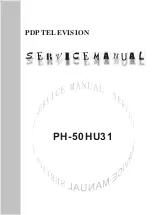
NOTICE:
Comply with all cautions and safety-related notes
located on or inside the cover case and on the chassis or plasma
module.
WARNING:
Since the chassis of this
receive
r is connected to
one side of the AC power supply during operation, whenever the
receiver is plugged in service should not be attempted by any-
one unfamiliar with the precautions necessary when working on
this type of receiver.
1. When service is required, an isolation transformer should be
inserted between power line and the receiver before any
service is performed on a “HOT” chassis receiver.
2. When replacing a chassis in the receiver, all the protective
devices must be put back in place, such as barriers, non-
metallic knobs, insulating cover-shields, and isolation
resistors, capacitors, etc.
3. When service is required, observe the original lead dress.
4. Always use manufacturer’s replacement components. Critical
components as indicated on the circuit diagram should not be
replaced by another manufacturer’s. Furthermore, where a
short circuit has occurred, replace those components that
indicate evidence of over heating.
5. Before returning a serviced receiver to the customer, the
service technician must thoroughly test the unit to be certain
that it is completely safe to operate without danger of electrical
shock, and be sure that no protective device built into the
receiver by the manufacturer has become defective, or
inadvertently defeated during servicing.
Therefore, the following checks should be performed for the
continued protection of the customer and service technician.
Leakage Current Cold Check
With the AC plug removed from the 120V AC 60Hz source,
place a jumper across Line 1 and Line 2 of the three plug
prongs, do not connect with the third prong, which is physical
ground.
Using an insulation tester (DC500V), connect one of its leads
to the AC plug jumper and touch with the other lead each
exposed metal part (antennas, screwheads, metal overlays,
control shafts, etc.), particularly any exposed metal part
having a return path to the chassis should have a resistor
reading over 4M
Ω
. Any resistance value below this range
indicates an abnormality which requires corrective action. An
exposed metal part not having a return path to the chassis will
indicate an open circuit.
SAFETY PRECAUTIONS
Leakage Current Hot Check
AC LEAKAGE TEST
ANY MEASUREMENTS NOT WITHIN THE LIMITS OUTLINED
ABOVE ARE INDICATIVE OF A POTENTIAL SHOCK HAZARD
AND MUST BE CORRECTED BEFORE RETURNING THE
RECEIVER TO THE CUSTOMER.
LEAKAGE
CURRENT
TESTER
(READING
SHOULD NOT
BE ABOVE 0.5MIU)
EARTH
GROUND
TEST ALL
EXPOSED
METAL SURFACES
DEVICE
UNDER
TEST
3-WIRE CORD
ALSO TEST WITH PLUG
REVERSED
(USING AC ADAPTER
PLUS AS REQUIRED)
Plug
the AC line cord directly into a 120V AC outlet. (Do not use an
isolation transformer during this test.) Use a leakage current
tester or a metering system that complies with the American
National Standards Institute (ANSI) C101.0 Leakage Current
for Appliances. In the case of the PDP monitor set the AC
switch first in the ON position and then in the OFF position,
measure from across Line 1 and Line 2 of the three plug
prongs, do not connect with the third prong, which is physical
ground, to all exposed metal parts of the instrument
(antennas, handle bracket, metal cabinet, screw heads,
metallic overlays, control shafts, etc.), especially any exposed
metal parts that offer an electrical return path to the chassis.
Any current measured must not exceed 0.5 MIU. Reverse the
instrument power cord plug in the outlet and repeat test.
LC67
TABLE OF CONTENTS
2
Summary of Contents for 50VS69A
Page 56: ...CONNECTION DIAGRAM TABLE OF CONTENTS 55 LC67 ...
Page 57: ...LC67 56 FINAL WIRING DIAGRAM TABLE OF CONTENTS ...
Page 58: ...LC67 57 FINAL WIRING DIAGRAM TABLE OF CONTENTS ...
Page 59: ...LC67 58 FINAL WIRING DIAGRAM TABLE OF CONTENTS ...
Page 60: ...LC67 59 FINAL WIRING DIAGRAM TABLE OF CONTENTS ...
Page 69: ...FINAL ASSEMBLY GUIDE TABLE OF CONTENTS 68 LC67 ...
Page 70: ...FINAL ASSEMBLY GUIDE 69 LC67 ...
Page 71: ...FINAL ASSEMBLY GUIDE 70 LC67 ...
Page 72: ...FINAL ASSEMBLY GUIDE 71 LC67 ...
Page 73: ...FINAL ASSEMBLY GUIDE 72 LC67 ...
Page 74: ...FINAL ASSEMBLY GUIDE 73 LC67 ...
Page 75: ...FINAL ASSEMBLY GUIDE 74 LC67 ...
Page 104: ...PRINTED CIRCUIT BOARDS LC67 POWER PWB Solder side LC67 103 ...
Page 122: ......




































